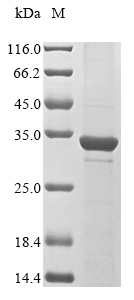Recombinant Human Peroxiredoxin-like 2A (PRXL2A)
CAT:
399-CSB-EP883589HU-03
Size:
20 µg
Price:
Ask
- Availability: 24/48H Stock Items & 2 to 6 Weeks non Stock Items.
- Dry Ice Shipment: No




Recombinant Human Peroxiredoxin-like 2A (PRXL2A)
- CAS Number: 9000-83-3
- Gene Name: PRXL2A
- UniProt: Q9BRX8
- Expression Region: 1-229aa
- Organism: Homo sapiens
- Target Sequence: MSFLQDPSFFTMGMWSIGAGALGAAALALLLANTDVFLSKPQKAALEYLEDIDLKTLEKEPRTFKAKELWEKNGAVIMAVRRPGCFLCREEAADLSSLKSMLDQLGVPLYAVVKEHIRTEVKDFQPYFKGEIFLDEKKKFYGPQRRKMMFMGFIRLGVWYNFFRAWNGGFSGNLEGEGFILGGVFVVGSGKQGILLEHREKEFGDKVNLLSVLEAAKMIKPQTLASEKK
- Tag: N-terminal 10xHis-tagged and C-terminal Myc-tagged
- Source: E.coli
- Field of Research: Cancer
- Assay Type: Developed Protein
- Relevance: Involved in redox regulation of the cell. Acts as an antioxidant. Inhibits TNFSF11-induced NFKB1 and JUN activation and osteoclast differentiation. May affect bone resorption and help to maintain bone mass . Acts as a negative regulator of macrophage-mediated inflammation by inhibiting macrophage production of inflammatory cytokines, probably through suppression of the MAPK signaling pathway .
- Purity: Greater than 85% as determined by SDS-PAGE.
- Activity: Not Test
- Length: Full Length
- Form: Liquid or Lyophilized powder
- Buffer: If the delivery form is liquid, the default storage buffer is Tris/PBS-based buffer, 5%-50% glycerol. If the delivery form is lyophilized powder, the buffer before lyophilization is Tris/PBS-based buffer, 6% Trehalose, pH 8.0.
- Reconstitution: We recommend that this vial be briefly centrifuged prior to opening to bring the contents to the bottom. Please reconstitute protein in deionized sterile water to a concentration of 0.1-1.0 mg/mL.We recommend to add 5-50% of glycerol (final concentration) and aliquot for long-term storage at -20℃/-80℃. Our default final concentration of glycerol is 50%. Customers could use it as reference.
- Molecular Weight: 33.2 kDa
- References & Citations: "Gene expression profiling in human fetal liver and identification of tissue- and developmental-stage-specific genes through compiled expression profiles and efficient cloning of full-length cDNAs." Yu Y., Zhang C., Zhou G., Wu S., Qu X., Wei H., XIng G., Dong C., Zhai Y., Wan J., Ouyang S., Li L., Zhang S., Zhou K., Zhang Y., Wu C., He F. Genome Res. 11:1392-1403 (2001)
- Storage Conditions: The shelf life is related to many factors, storage state, buffer ingredients, storage temperature and the stability of the protein itself. Generally, the shelf life of liquid form is 6 months at -20℃/-80℃. The shelf life of lyophilized form is 12 months at -20℃/-80℃.
